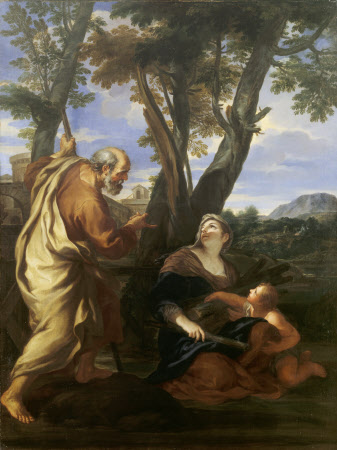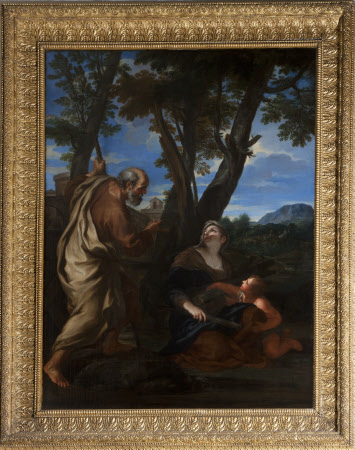Elijah and the Widow of Serepta (Zarephath)
Ciro Ferri (Rome 1634 - Rome 1689)
Category
Art / Oil paintings
Date
1669 - 1689
Materials
Oil on canvas
Measurements
1308 x 978 mm (51 ½ x 38 ½ in)
Place of origin
Italy
Order this imageCollection
Kedleston Hall, Derbyshire
NT 108845
Summary
Oil painting on canvas, Elijah and the Widow of Serepta (Zarephath) by Ciro Ferri (Rome 1634 – Rome 1689). This picture shows Elijah, wearing the Carmelite habit of white mantle over brown tunic, encountering the widow of Sarepta gathering sticks, with her son, who was very ill. According to the Biblical story (I Kings 17: 8-24), the brook where Elijah was staying in the desert dried up so he moved to the city where he met a widow, who gave him food and drink, and whose son he revived from a fatal illness. Though clearly conceived as pendants, in England they have always also been thought to be of the same subject, Hagar and Ishmael. Ferri was the pupil and most faithful imitator of Pietro da Cortona after whose death (d.1669) he became one of the three leading painters in Rome.
Provenance
Recorded for the first time with its pendant (NT 108846) - in the list of paintings offered for sale by the three Arnaldi brothers, marchese Tommaso, abate Bartolomeo, and cavaliere Maurizio, to Senatore marchese Vincenzo Riccardi, in 1749 (Rudolph, op.cit., Appendix IV, p.234, nos. 35 & 36)[not in 1752 Riccardi inventory]; announced by the dealer William Kent, in his letter to Sir Nathaniel Curzon (later 1st Lord Scarsdale) (1726-1804) of 29 September 1758, as amongst “some of [Marquis Arnaldi’s] best pictures”, for which he was in treaty, as: “2 Ciro Ferri istoria sacra” (doc. first discovered and transcribed by Sir Brinsley Ford; Rudolph, op.cit., p.174); and listed amongst his successfully included purchases, in his letter to the same of 2 October 1758: “Ceri Ferri Istoria Sacra These were ever esteem’d the best he ever painted & will please you much” (doc. likewise first transcr. by Sir Brinsley Ford; Rudolph, op.cit., Appendix V, p.239, nos. 13 & 14); recorded in Dining Room in 1769; and thence by descent bought with part of the contents of Kedleston with the aid of the National Heritage Memorial Fund in 1987 when the house and park were given to the National Trust by Francis Curzon, 3rd Viscount Scarsdale (1924-2000)
Credit line
Kedleston Hall, The Scarsdale Collection (acquired with the help of the National Heritage Memorial Fund and transferred to The National Trust in 1987)
Makers and roles
Ciro Ferri (Rome 1634 - Rome 1689), publisher


